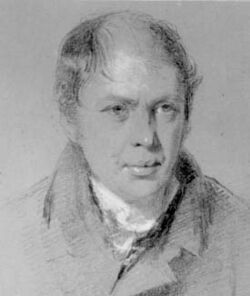Biography:William Wallace (mathematician)
William Wallace FRSE MInstCE FRAS LLD (23 September 1768 – 28 April 1843) was a Scottish mathematician and astronomer who invented the eidograph (an improved pantograph).
Life
Wallace was born at Dysart in Fife, the son of Alexander Wallace, a leather manufacturer, and his wife, Janet Simson.[1] He received his school education in Dysart and Kirkcaldy.
In 1784 his family moved to Edinburgh, where he himself was set to learn the trade of a bookbinder.[2] In 1790 he appears as "William Wallace, bookbinder" living and trading at Cowgatehead, at the east end of the Grassmarket.[3]
His taste for mathematics had already developed itself, and he made such use of his leisure hours that before the completion of his apprenticeship he had made considerable acquirements in geometry, algebra and astronomy. He was further assisted in his studies by John Robison (1739–1805) and John Playfair, to whom his abilities had become known.[2]
After various changes of situation, dictated mainly by a desire to gain time for study, he became assistant teacher of mathematics in the Perth Academy in 1794. This post he exchanged in 1803 for a mathematical mastership in the Royal Military College at Great Marlow, in which post he continued after it moved to Sandhurst, with a recommendation by Playfair.[2]
In 1804 he was elected a Fellow of the Royal Society of Edinburgh.[2] His proposers were John Playfair, Thomas Charles Hope and William Wright.[4]
In 1819 he was chosen to succeed John Playfair in the chair of mathematics at Edinburgh. Playfair's second chair (in Natural Philosophy) was taken by John Leslie.
Wallace developed a reputation for being an excellent teacher. Among his students was Mary Somerville. In 1838 he retired from the university due to ill health.[2] In his final years he lived at 6 Lauriston Lane on the south side of Edinburgh.[5]
He died in Edinburgh and was buried in Greyfriars Kirkyard. The grave lies on the north-facing retaining wall in the centre of the northern section.
Mathematical contributions
In his earlier years Wallace was an occasional contributor to Leybourne's Mathematical Repository and the Gentleman's Mathematical Companion. Between 1801 and 1810 he contributed articles on "Algebra", "Conic Sections", "Trigonometry", and several others in mathematical and physical science to the fourth edition of the Encyclopædia Britannica, and some of these were retained in subsequent editions from the fifth to the eighth inclusive. He was also the author of the principal mathematical articles in the Edinburgh Encyclopædia, edited by David Brewster. He also contributed many important papers to the Transactions of the Royal Society of Edinburgh.[2]
He mainly worked in the field of geometry and in 1799 became the first to publish the concept of the Simson line, which erroneously was attributed to Robert Simson.[6] In 1807 he proved a result about polygons with an equal area, that later became known as the Bolyai–Gerwien theorem.[7] His most important contribution to British mathematics however was, that he was one of the first mathematicians introducing and promoting the advancement of the continental European version of calculus in Britain.[6]
Other works
Wallace also worked in astronomy and invented the eidograph, a mechanical device for scaling drawings.[6][8]
Books
- A Geometrical Treatise on the Conic Sections with an Appendix Containing Formulae for their Quadrature. (1838)
- Geometrical Theorems and Analytical Formulae with their application to the Solution of Certain Geodetical Problems and an Appendix. (1839)
Family
Wallace was married to Janet Kerr (1775–1824).
His daughter, Margaret Wallace, married the mathematician Thomas Galloway. His sons included the Rev Alexander Wallace (1803–1842) and Archibald C. Wallace (1806–1830).
He also appears to have had a son William Wallace (1784–1864) when William was aged only 16. The mother is not clear.
References
- ↑ "William Wallace - Biography". https://mathshistory.st-andrews.ac.uk/Biographies/Wallace/.
- ↑ 2.0 2.1 2.2 2.3 2.4 2.5 Chisholm 1911.
- ↑ Williamson's Edinburgh Directory 1790
- ↑ Biographical Index of Former Fellows of the Royal Society of Edinburgh 1783–2002. The Royal Society of Edinburgh. July 2006. ISBN 978-0-902198-84-5. https://www.royalsoced.org.uk/cms/files/fellows/biographical_index/fells_indexp2.pdf.
- ↑ Edinburgh and Leith Post Office directory 1835-36
- ↑ 6.0 6.1 6.2 O'Connor, John J.; Robertson, Edmund F., "William Wallace (mathematician)", MacTutor History of Mathematics archive, University of St Andrews, http://www-history.mcs.st-andrews.ac.uk/Biographies/Wallace.html.
- ↑ Ian Stewart: From Here to Infinity. Oxford University Press 1996 (3. edition), ISBN 978-0-19-283202-3, p. 169 (restricted online copy, p. 169, at Google Books)
- ↑ Gerard L'Estrange Turner: Nineteenth-Century Scientific Instruments. University of California Press 1983, ISBN 0-520-05160-2, p. 280 (online copy, p. 280, at Google Books)
Sources
External links
- O'Connor, John J.; Robertson, Edmund F., "William Wallace (mathematician)", MacTutor History of Mathematics archive, University of St Andrews, http://www-history.mcs.st-andrews.ac.uk/Biographies/Wallace.html.
- Short biographical note on William Wallace in the Gazetteer for Scotland



